Centro de las Artes de San Luis Potosí | Central Gallery
Exhibition Dates: 3 July – 10 August 2025
By Angela Pérez
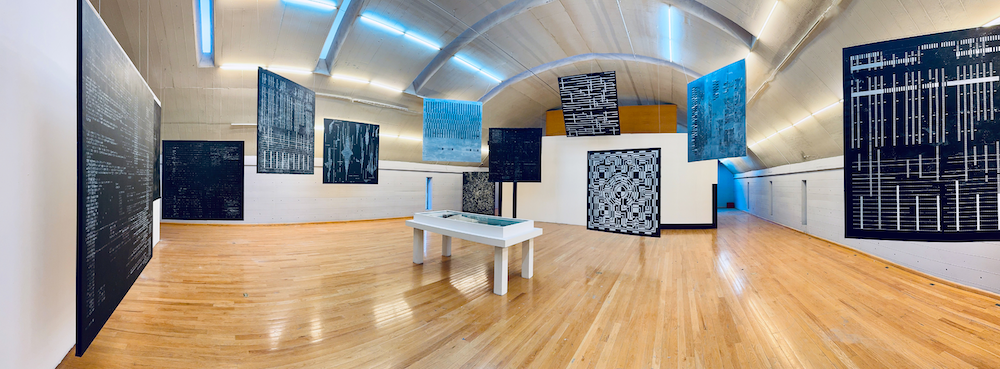
CÓDIGOS. Centro de las Artes de San Luis Potosí, Mexico. Central Gallery
ITP Alumni and acclaimed Mexican artist, Ernesto Ríos has opened his 28th solo exhibition, CÓDIGOS, at the Centro de las Artes de San Luis Potosí (CEART).
Recognized as one of the foremost artists of his generation, the acclaimed multidisciplinary artist opened the exhibition on 3 July, showing till 10 August. The exhibition offers a sensory and conceptual journey through large-scale paintings and high-fired ceramics, inviting viewers to reflect on the intersections between biological systems and digital languages. Visitors enter a living architecture of symbols, algorithms, and rhythms—a space where the invisible is made tangible.
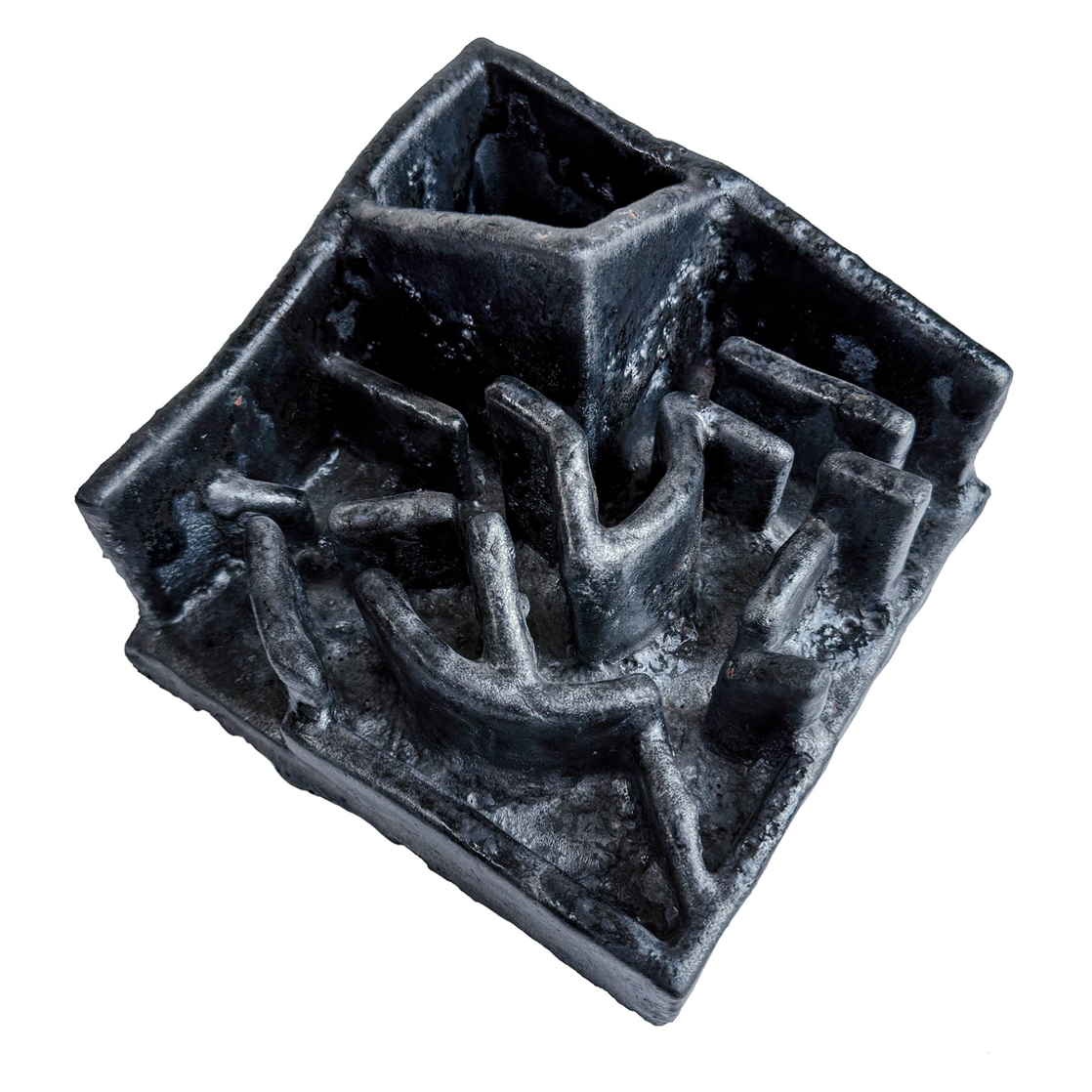
Untitled. Technique: High-fire ceramics
The Origin of CÓDIGOS
The origins of this exhibition however reaches back to Ernesto Ríos’s earliest encounters with programming. Titling the exhibition CÓDIGOS, ‘code’ in Spanish, the conceptual idea emerged from when he first learnt basic coding in elementary school using the ‘logo’ program, developed by Wally Feurzeig, Seymour Papert, and Cynthia Solomon, where a cursor was represented by a turtle. Years later, during his graduate studies at New York University’s Interactive Telecommunications Program (ITP), he encountered programming and digital tools that hugely expanded his creative vocabulary and artistic possibilities.
“As I entered this universe of coding and programming, it felt as though a vast realm of creative possibility had opened up.”
— Ernesto Ríos
At ITP, Ríos developed interactive artworks integrating sensors, movement, and sound — experiments that were both two-dimensional and deeply immersive on a sensory level. These pieces invited viewers to experience space and time through direct, tactile engagement using organic materials and found objects.
“During this period, I was interested in making the intangible tangible through the interconnection of art, science, and technology.”
— Ernesto Ríos
This phase marked a turning point, forging a deep interest in the exchange between technology, human perception, and symbolic language. This interest continues to shape his artistic inquiry today.
Visualizing the Unseen: Systems, Patterns, Dynamism
CÓDIGOS, the exhibition builds on this trajectory, merging organic forms with digital structures. Using binary sequences, genetic motifs, and algorithmic geometries, these images emerge in a restrained palette of white, black, and metallics developing an aesthetic Ríos uses to explore dualities and tonal nuance.
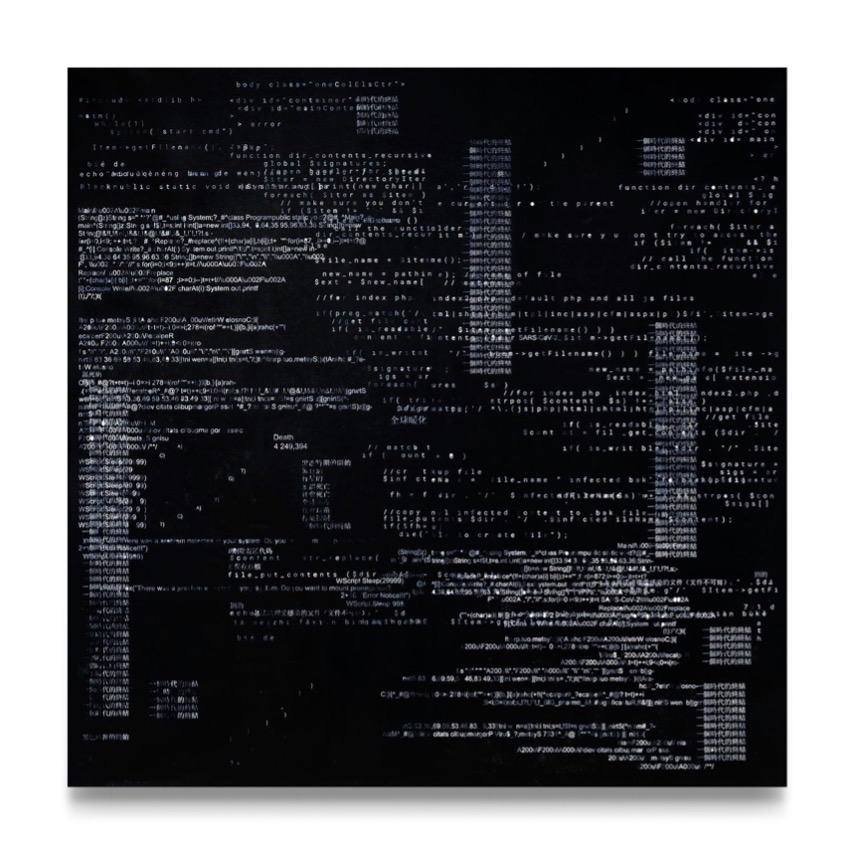
Title: 武汉 Code / Wuhan Code Ernesto Rios. Mixed media on canvas, 200 x 200 cm. 2021-2025.
“My interest lies in only working with a limited palette. Creating monochromatic works to explore complementary opposites in tension: light and shadow, micro and macro, night and day, order and chaos, and examining the infinite tones in between.”
— Ernesto Ríos
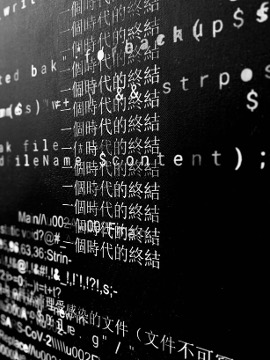
Detail: 武汉 Code / Wuhan Code, Ernesto Rios. Mixed media on canvas, 200 x 200 cm. 2021-2025.
Paintings that pulse with rhythmic grids and fractal geometries grow tension. Ceramics, created using Raku, a traditional Japanese low-temperature firing technique bear crackled glazes, charred textures, and smoky surfaces. Known for its unpredictability, Raku emphasizes imperfection, spontaneity, and transformation through fire. These tactile, elemental works evoke ancestral processes even as they engage with themes of data and digitization.
“I focus on an artisanal intelligence that begins with the hands and a reliance on the four elements — earth, fire, water and air — and perhaps a fifth: intuition. This enables for the inclusion of sensitivity and spirit.”
— Ernesto Ríos
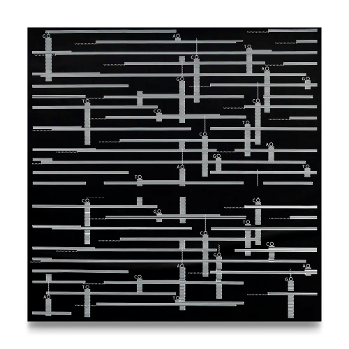
Title: V Code Ernesto Rios. Mixed media on canvas, 200 x 200 cm. 2021-2025.
Installation as Metaphor: Geometry in Motion
Ríos’s spatial design echoes the spiral architecture of DNA. Paintings float, suspended on steel cables, guiding viewers along a circular path. This choreography transforms the gallery into a navigable system of signs and sequences, one to be experienced as much as seen. The installation becomes both a visual metaphor and a cognitive map.
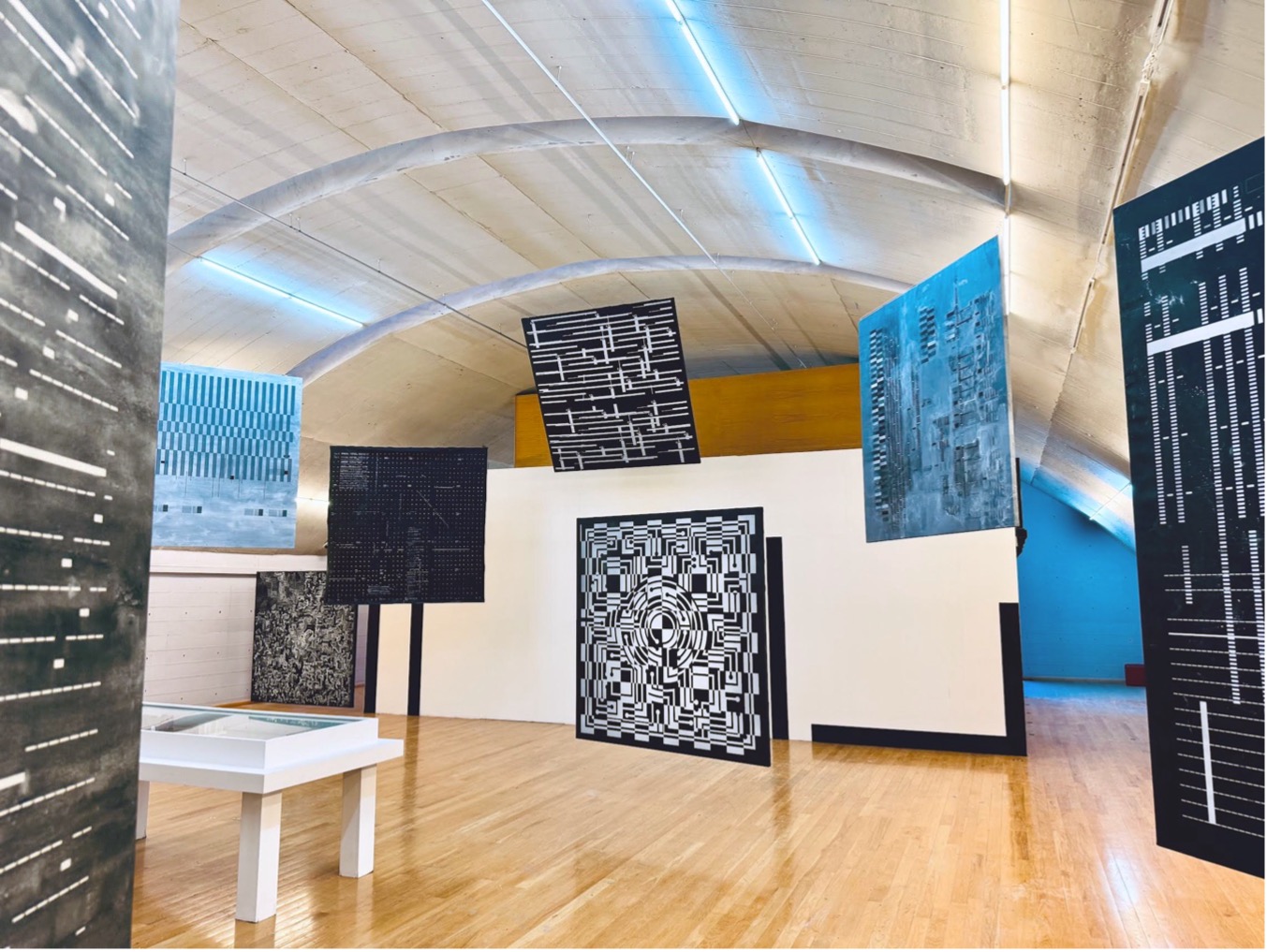
CÓDIGOS. Centro de las Artes de San Luis Potosí, Mexico. Central Gallery.
The Poetics of Opposites: Taoism and Visual Rhythm
CÓDIGOS the exhibition however draws on Taoist philosophy, especially the principle of yin and yang, viewing opposites not as contradictions but as complementary forces in constant tension. Ríos’s work embodies this dialectic by exploring pairs such as light and shadow, control and chaos, micro and macro. Rather than seeking to resolve these tensions, the art delves into their generative potential, revealing the invisible underlying structures—vibrations, sequences, and repetitions—that connect and balance these opposing yet interdependent forces.
From Artificial to Artistic Intelligence
In an era dominated by artificial intelligence, CÓDIGOS reclaims a slower, more tactile way of knowing, one rooted in material practice and intuitive process.
“My current work is focused more on developing an artistic intelligence—one intensely connected to the mind, the body, and perhaps even the spirit, in a metaphorical sense.”
— Ernesto Ríos
This philosophy resonates throughout the exhibition. Each brushstroke and ceramic fracture carries the weight of labor, intention, and memory—forming a quiet but insistent counterpoint to the logic of automation. Rather than artificial intelligence, Ríos evokes a different kind of cognition: embodied, intuitive, and rooted in material experience. It is a way of knowing, shaped not by algorithms but by the hand. The works denote skill and craft, gained by repetition and presence.
Encoded Life: Between Geometry and Memory
Curator Gabriela Gorab comments:
“The works gathered in CÓDIGOS emerge from a research process where science, art, geometry, introspection, and memory intertwine as potential codes of life and evolution. In each piece, Ríos constructs visual tapestries that evoke sequences, algorithms, spores, fractals, vibrations, and organic structures. Everything feels encoded: patterns, shapes, and pulses that invite us to consider life beyond biology—as a network of flows, rhythms, and resonances.”
— Gabriela Gorab, curator
Some works incorporate natural pigments and eco-conscious materials. Others draw on Ríos’s personal history—textures and forms nurtured by lived experience.
Zoonosis: Viral Codes and Ecological Collapse
ZOONOSIS is a video installation that explores the transference of infectious diseases from animals to humans—a phenomena intensified by global interconnectivity and ecological disruption. This project arises from an interdisciplinary research process that merges art, science, and technology, producing a visual and sonic experience that reflects on the complexity of our increasingly digital, and biologically fragile era.
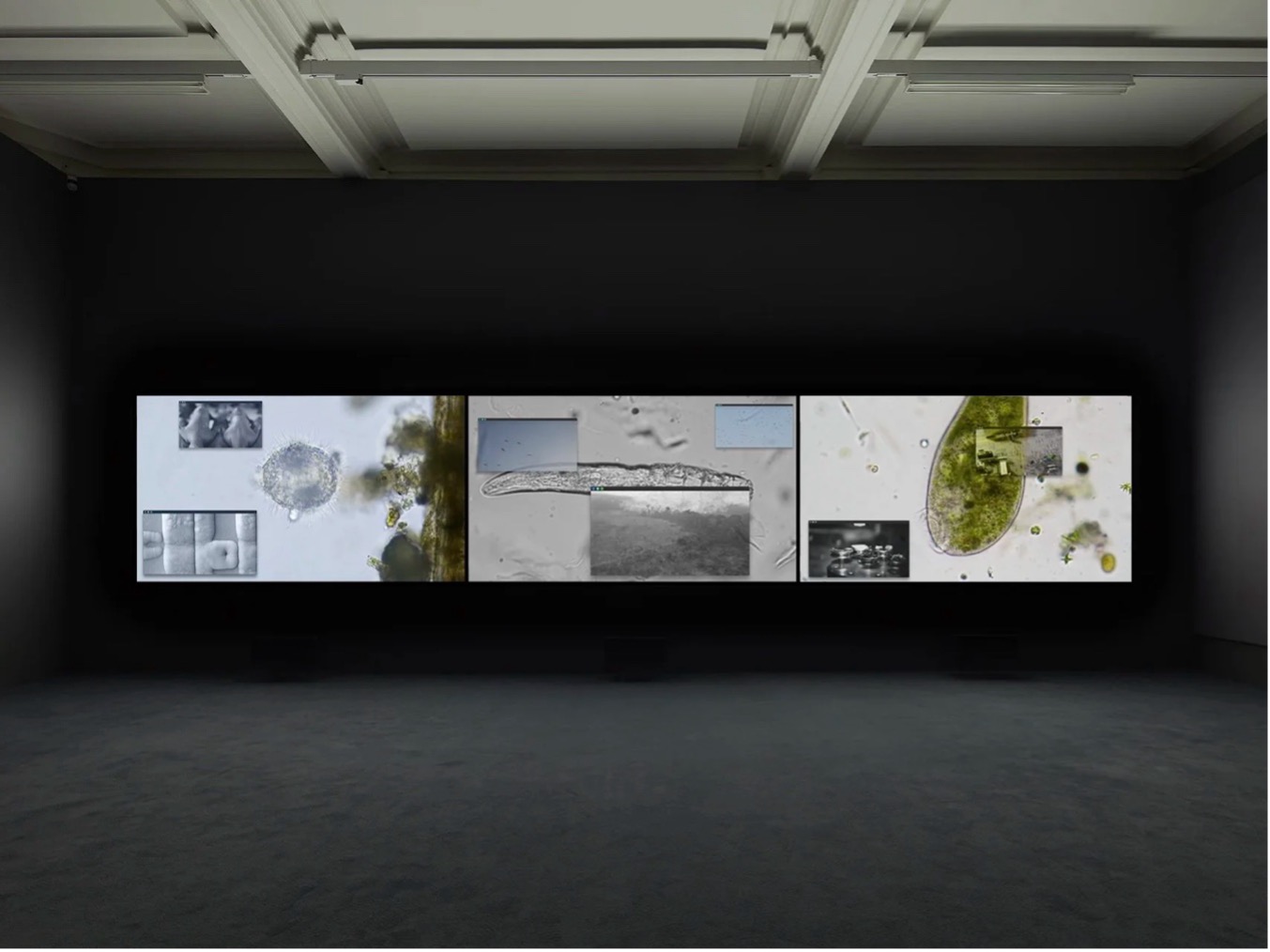
Zoonosis. Video installation. 2021. Ernesto Rios.
Zoonosis: Viral Codes and Ecological Collapse
ZOONOSIS is a video installation that examines the transmission of infectious diseases from animals to humans, intensified by ecological disruption and global interconnectivity. Emerging from a transdisciplinary research process, the work merges art, science, and technology to create a poetic visual and sonic experience of our biologically fragile and digitally saturated era.
Layered screens display interwoven images—nanotechnology, circuits, vaccines, and decaying ecosystems—forming visual codes sourced from scientific archives and speculative media. The immersive soundscape, composed with microbiologist and sound artist Jacques Soddell, fuses electronic textures with environmental echoes, generating a "viral poetics" of noise, data, and organic resonance.
“Zoonosis is both a biological and a symbolic threshold… a way to understand contemporary life itself.”
— Ernesto Ríos
Presented in the former panopticon prison now housing the Centro de las Artes de San Luis Potosí, the installation reflects on surveillance, perception, and the invisible systems that shape society today.
“It appears that because we don’t see these codes—because they are invisible—we don’t realize how society itself is being programmed.”
— Ernesto Ríos
Building Transdisciplinary Practice
Ernesto Ríos holds a Master’s degree with honors from NYU’s Tisch School of the Arts (ITP) and a Ph.D. in Visual Arts from RMIT University in Australia, where he developed the institution’s first interactive thesis. He currently teaches classes and research seminars at the Faculty of Architecture and Design at the Universidad Autónoma del Estado de Morelos, covering undergraduate, master’s, and doctoral programs in architecture, art, photography, and design with a transdisciplinary perspective.
His work has been exhibited in over 25 countries across the Americas, Europe, Asia, and Oceania. As a visual artist and co-photographic author, he has contributed to more than 20 books and participated in over 70 group exhibitions and 28 solo shows. His photographic series Archivos Compartidos Tres Ríos has been recognized by UNESCO’s Memory of the World program for its cultural and documentary significance.

Ernesto Rios at his studio in Mexico.
CÓDIGOS
CÓDIGOS is more than a series of artworks—it’s a living system. Through vibrant shapes and forms, Ríos invites viewers to explore the connections between matter, digital codes, memory, and change.
“I aim to create a sensory and intellectual experience that not only engages the senses but also encourages fresh inquiries into the complex relationship between the organic and the digital.
Through this exploration, I hope to inspire critical interpretations that deepen our understanding of today’s intricate reality and spark creativity that leads to positive change in how we perceive and interact with both natural and technological worlds.”
— Ernesto Ríos
For more information visit:
Instagram: https://www.instagram.com/______ernesto_rios/
Facebook: https://www.facebook.com/ernestoriosart/
Website: https://www.ernestorios.net